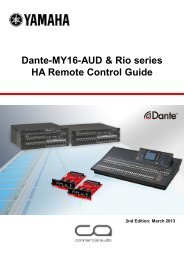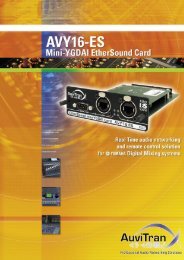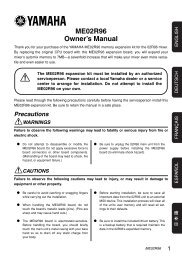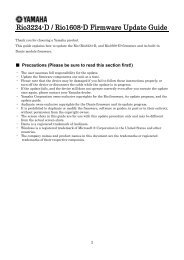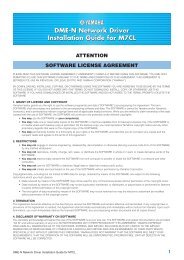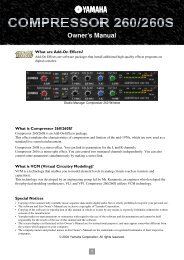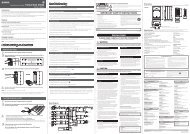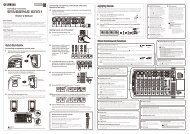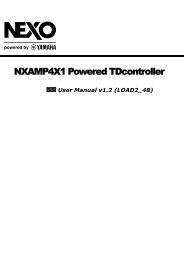01V96 V2 Editor Manual - Yamaha Commercial Audio
01V96 V2 Editor Manual - Yamaha Commercial Audio
01V96 V2 Editor Manual - Yamaha Commercial Audio
Create successful ePaper yourself
Turn your PDF publications into a flip-book with our unique Google optimized e-Paper software.
Selected Channel Window<br />
❏<br />
The Selected Channel window allows detailed editing of the currently selected channel. To open the<br />
Selected Channel window, choose [Selected Channel] from the [Windows] menu.<br />
There are five variations of the layout of the Selected Channel window, as follows:<br />
Input Channels<br />
• Input Channels (see below)<br />
• Stereo Input Channels (see page 16)<br />
• Bus Outs (see page 17)<br />
• Aux Sends (see page 18)<br />
• Stereo Outs (see page 19)<br />
Note: You can open multiple Selected Channel windows by choosing [Windows] menu -><br />
[Selected Channel] -> [Additional View]. The titles of these windows will indicate<br />
[Locked]. You cannot open Library windows from windows that are indicated as [Locked].<br />
In addition, these windows will not reflect the following operations:<br />
• Channel selections made in the Layer window (via the SELECT button)<br />
• Edits in the Surround <strong>Editor</strong> window<br />
AB C D E F<br />
G H I<br />
A CHANNEL SELECT, INPUT PATCH & LIBRARY section<br />
Channels can be selected by clicking the Channel ID and selecting from the list that appears, or by<br />
clicking the left and right Channel Select buttons. The long channel name is displayed below the Channel<br />
ID. To edit the name, click it and type. The INPUT PATCH parameter is used to select an input<br />
source. To select an input, click the parameter and choose from the list that appears. The [LIBRARY]<br />
button opens the Channel Library window.<br />
B GATE section<br />
This section contains the Gate controls and display graph for the currently selected Input Channel.<br />
The rotary controls are used to set the threshold, range, attack, decay, and hold. The GR meter indicates<br />
the amount of gain reduction being applied by the Gate. The OUT meter indicates its output<br />
level. The [ON] button turns the Gate on and off. The [LINK] button links the Gate of the currently<br />
selected Input Channel with the Gate of its partner channel. The KEY IN parameter is used to select a<br />
Gate trigger source. The [LIBRARY] button opens the Gate Library window.<br />
<strong>01V96</strong> <strong>Editor</strong>—Owner’s <strong>Manual</strong><br />
14<br />
Getting Started<br />
Using Windows <strong>01V96</strong> <strong>Editor</strong><br />
Windows<br />
Keyboard Shortcuts<br />
Index



